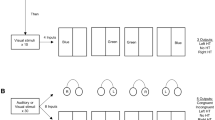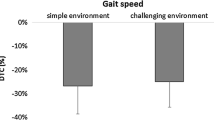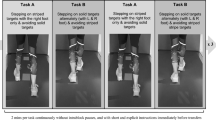Abstract
A U-shaped relationship between cognitive demand and gait control may exist in dual-task situations, reflecting opposing effects of external focus of attention and attentional resource competition. The purpose of the study was twofold: to examine whether gait control, as evaluated from step-to-step variability, is related to cognitive task difficulty in a U-shaped manner and to determine whether age modifies this relationship. Young and older adults walked on a treadmill without attentional requirement and while performing a dichotic listening task under three attention conditions: non-forced (NF), forced-right (FR), and forced-left (FL). The conditions increased in their attentional demand and requirement for inhibitory control. Gait control was evaluated by the variability of step parameters related to balance control (step width) and rhythmic stepping pattern (step length and step time). A U-shaped relationship was found for step width variability in both young and older adults and for step time variability in older adults only. Cognitive performance during dual tasking was maintained in both young and older adults. The U-shaped relationship, which presumably results from a trade-off between an external focus of attention and competition for attentional resources, implies that higher-level cognitive processes are involved in walking in young and older adults. Specifically, while these processes are initially involved only in the control of (lateral) balance during gait, they become necessary for the control of (fore-aft) rhythmic stepping pattern in older adults, suggesting that attentional resources turn out to be needed in all facets of walking with aging. Finally, despite the cognitive resources required by walking, both young and older adults spontaneously adopted a “posture second” strategy, prioritizing the cognitive task over the gait task.


Similar content being viewed by others
References
Andersson M, Reinvang I, Wehling E, Hugdhal K, Lundervold AJ (2008) A dichotic listening study of attention control in older adults. Scand J Psychol 49:299–304
Asbjørnsen A, Hugdahl K (1995) Attentional effects in dichotic listening. Brain Lang 49:189–201
Asbjørnsen A, Holmefjord A, Reisaeter S, Møller P, Klausen O, Prytz B, Boliek C, Obrzut JE (2000) Lasting auditory attention impairment after persistent middle ear infections: a dichotic listening study. Dev Med Child Neurol 42:481–486
Aylward GP, Gordon M, Verhulst SJ (1997) Relationships between continuous performance task scores and other cognitive measures: causality or commonality. Assessment 4:325–336
Beauchet O, Dubost V, Aminian K, Gonthier R, Kressig RW (2005a) Dual-task-related gait changes in the elderly: does the type of cognitive task matter? J Mot Behav 37:259–264
Beauchet O, Dubost V, Herrmann FR, Kressig RW (2005b) Stride-to-stride variability while backward counting among healthy young adults. J Neuroeng Rehabil 2:26
Bloem BR, Grimbergen YA, van Dijk JG, Munneke M (2006) The “posture second” strategy: a review of wrong priorities in Parkinson’s disease. J Neurol Sci 248:196–204
Bouma A, Gootjes L (2011) Effects of attention on dichotic listening in elderly and patients with dementia of the Alzheimer type. Brain Cogn 76:286–293. doi:10.1016/j.bandc.2011.02.008
Brach JS, Berlin JE, VanSwearingen JM, Newman AB, Studenski SA (2005) Too much or too little step width variability is associated with a fall history in older persons who walk at or near normal gait speed. J Neuroeng Rehabil 2:21. doi:10.1186/1743-0003-2-21
Braver TS, Cohen JD (2000) On the control of control: the role of dopamine in regulating prefrontal function and working memory. In: Monsell S, Driver J (eds) Attention and performance XVIII. MIT Press, Cambridge, MA, pp 713–737
Braver TS, Cohen JD, Barch DM (2002) The role of prefrontal cortex in normal and disordered cognitive control: a cognitive neuroscience perspective. In: Stuss DT, Knight RT (eds) Principles of frontal lobe function. Oxford University Press, New York, pp 428–448
Bryden MP (1988) An overview of the dichotic listening procedure and its relation to cerebral organization. In: Hugdahl K (ed) Handbook of dichotic listening: theory, methods, and research. Wiley & Sons, Chichester, UK, pp 1–44
Bryden MP, Munhall K, Allard F (1983) Attentional biases and the right-ear effect in dichotic listening. Brain Lang 18:236–248
Bush G, Luu P, Posner MI (2000) Cognitive and emotional influences in the anterior cingulate cortex. Trends Cogn Sci 4:215–222
Buzzi UH, Stergiou N, Kurz MJ, Hageman PA, Heidel J (2003) Nonlinear dynamics indicates aging affects variability during gait. Clin Biomech 18:435–443
Cherry EC (1953) Some experiments on the recognition of speech, with one and with two ears. J Acoust Soc Am 25:975–979
Cignetti F, Decker LM, Stergiou N (2012) Sensitivity of the Wolf’s and Rosenstein’s algorithms to evaluate local dynamic stability from small gait data sets: response to commentaries by Bruijn et al. Ann Biomed Eng 40:2507–2509. doi:10.1007/s10439-012-0665-6
Decker LM, Cignetti F, Potter JF, Studenski SA, Stergiou N (2012) Use of motor abundance in young and older adults during dual-task treadmill walking. PLoS One 7, e41306. doi:10.1371/journal.pone.0041306
Decker LM, Cignetti F, Stergiou N (2013) Executive function orchestrates regulation of task-relevant gait fluctuations. Gait Posture 38:537–540. doi:10.1016/j.gaitpost.2012.12.018
Della Penna S, Brancucci A, Babiloni C, Franciotti R, Pizzella V, Rossi D, Torquati K, Rossini PM, Romani GL (2007) Lateralization of dichotic speech stimuli is based on specific auditory pathway interactions: neuromagnetic evidence. Cereb Cortex 17:2303–2311
Diamond A (2013) Executive functions. Annu Rev Psychol 64:135–168. doi:10.1146/annurev-psych-113011-143750
Dingwell JB, Cusumano JP (2015) Identifying stride-to-stride control strategies in human treadmill walking. PLoS One 10, e0124879. doi:10.1371/journal.pone.0124879
Dingwell JB, Cusumano JP, Cavanagh PR, Sternad D (2001) Local dynamic stability versus kinematic variability of continuous overground and treadmill walking. J Biomech Eng 123:27–32
Dingwell JB, John J, Cusumano JP (2010) Do humans optimally exploit redundancy to control step variability in walking? PLoS Comput Biol 6, e1000856. doi:10.1371/journal.pcbi.1000856
Dubost V, Kressig RW, Gonthier R, Herrmann FR, Aminian K, Najafi B, Beauchet O (2006) Relationships between dual-task related changes in stride velocity and stride time variability in healthy older adults. Hum Movement Sci 25:372–382
Dubost V, Annweiler C, Aminian K, Najafi B, Herrmann FR, Beauchet O (2008) Stride-to-stride variability while enumerating animal names among healthy young adults: result of stride velocity or effect of attention-demanding task? Gait Posture 27:138–143
Folstein MF, Folstein SE, McHugh PR (1975) “Mini-mental state”. A practical method for grading the cognitive state of patients for the clinician. J Psychiatr Res 12:189–198
Foundas AL, Corey DM, Hurley MM, Heilman KM (2006) Verbal dichotic listening in right and left-handed adults: laterality effects of directed attention. Cortex 42:79–86
Gabell A, Nayak US (1984) The effect of age on variability in gait. J Gerontol 39:662–666
Grabiner MD, Troy KL (2005) Attention demanding tasks during treadmill walking reduce step width variability in young adults. J Neuroeng Rehabil 2:25
Griggs RA, Platt RD, Newstead SE, Jackson SL (1998) Attentional factors in a disjunctive reasoning task. Think Reason 4:1–14
Hausdorff JM (2005) Gait variability: methods, modeling and meaning. J Neuroeng Rehabil 2:19
Hausdorff JM, Rios DA, Edelberg HK (2001) Gait variability and fall risk in community-living older adults: a 1-year prospective study. Arch Phys Med Rehabil 82:1050–1056
Herman T, Mirelman A, Giladi N, Schweiger A, Hausdorff JM (2010) Executive control deficits as a prodrome to falls in healthy older adults: a prospective study linking thinking, walking, and falling. J Gerontol A Biol Sci Med Sci 65:1086–1092. doi:10.1093/gerona/glq077
Hill KD, Schwarz JA, Kalogeropoulos AJ, Gibson SJ (1996) Fear of falling revisited. Arch Phys Med Rehabil 77:1025–1029
Hollman JH, Kovash FM, Kubik JJ, Linbo RA (2007) Age-related differences in spatiotemporal markers of gait stability during dual task walking. Gait Posture 26:113–119
Holtzer R, Wang C, Verghese J (2014) Performance variance on walking while talking tasks: theory, findings, and clinical implications. Age (Dordr) 36:373–381. doi:10.1007/s11357-013-9570-7
Hugdahl K (2003) Dichotic listening in the study of auditory laterality. In: Hugdahl K, Davidson RJ (eds) The asymmetrical brain. MIT Press, Cambridge, MA, pp 441–476
Hugdahl K, Andersson L (1986) The “forced-attention paradigm” in dichotic listening to CV-syllables: a comparison between adults and children. Cortex 22:417–432
Hugdahl K, Westerhausen R, Alho K, Medvedev S, Laine M, Hämäläinen H (2009) Attention and cognitive control: unfolding the dichotic listening story. Scand J Psychol 50:11–22. doi:10.1111/j.1467-9450.2008.00676.x
Hunt E, Lansman M (1986) Unified model of attention and problem solving. Psychol Rev 93:446–461
Huxhold O, Li SC, Schmiedek F, Lindenberger U (2006) Dual tasking postural control. Aging and the effects of cognitive demand in conjunction with focus of attention. Brain Res Bull 69:294–305
Jordan K, Challis JH, Newell KM (2007) Walking speed influences on gait cycle variability. Gait Posture 26:128–134
Kang HG, Dingwell JB (2008) Separating the effects of age and walking speed on gait variability. Gait Posture 27:572–577
Kimura D (1961) Cerebral dominance and the perception of verbal stimuli. Can J Psychol 15:166–171
Kinsbourne M (1970) The cerebral basis of lateral asymmetries in attention. Acta Psychol (Amst) 33:193–201
Kinsbourne M (1975) The mechanism of hemispheric control of the lateral gradient of attention. In: Rabbitt PMA, Dornic S (eds) Attention and performance V. Academic, London, New York
Kressig RW, Herrmann FR, Grandjean R, Michel JP, Beauchet O (2008) Gait variability while dual-tasking: fall predictor in older inpatients? Aging Clin Exp Res 20:123–130
Li KZ, Lindenberger U (2002) Relations between aging sensory/sensorimotor and cognitive functions. Neurosci Biobehav Rev 26:777–783
Lindenberger U, Baltes PB (1994) Sensory functioning and intelligence in old age: a strong connection. Psychol Aging 9:339–355
Lövdén M, Schaefer S, Pohlmeyer AE, Lindenberger U (2008) Walking variability and working memory load in aging: a dual-process account relating cognitive control to motor control performance. J Gerontol B Psychol Sci Soc Sci 63:P121–P128
Miller EK, Cohen JD (2001) An integrative theory of prefrontal cortex function. Annu Rev Neurosci 24:167–212
Monaco M, Costa A, Caltagirone C, Carlesimo GA (2013) Forward and backward span for verbal and visuo-spatial data: standardization and normative data from an Italian adult population. Neurol Sci 34:749–754. doi:10.1007/s10072-012-1130-x
Montero-Odasso M, Muir SW, Hall M, Doherty TJ, Kloseck M, Beauchet O, Speechley M (2011) Gait variability is associated with frailty in community-dwelling older adults. J Gerontol A Biol Sci Med Sci 66:568–576. doi:10.1093/gerona/glr007
Newell KM, Corcos DM (1993) Issues in variability and motor control. In: Newell KM, Corcos DM (eds) Variability and motor control. Human Kinetics, Champaign, IL, pp 1–12
Nigg BM, Cole GK, Nachbauer W (1993) Effects of arch height of the foot on angular motion of the lower extremities in running. J Biomech 26:909–916
Oldfield RC (1971) The assessment and analysis of handedness: the Edinburgh inventory. Neuropsychologia 9:97–113
Owings TM, Grabiner MD (2004) Variability of step kinematics in young and older adults. Gait Posture 20:26–29
Redfern MS, Jennings JR, Martin C, Furman JM (2001) Attention influences sensory integration for postural control in older adults. Gait Posture 14:211–216
Redfern MS, Jennings JR, Mendelson D, Nebes RD (2009) Perceptual inhibition is associated with sensory integration in standing postural control among older adults. J Gerontol B Psychol Sci Soc Sci 64:P569–P576. doi:10.1093/geronb/gbp060
Schaefer S, Huxhold O, Lindenberger U (2006) Healthy mind in healthy body? A review of sensorimotor-cognitive interdependencies in old age. Eur Rev Aging Phys Act 3:45–54
Schaefer S, Lövdén M, Wieckhorst B, Lindenberger U (2010) Cognitive performance is improved while walking: differences in cognitive-sensorimotor couplings between children and young adults. Eur J Dev Psychol 7:371–389
Schaefer S, Jagenow D, Verrel J, Lindenberger U (2015) The influence of cognitive load and walking speed on gait regularity in children and young adults. Gait Posture 41:258–262. doi:10.1016/j.gaitpost.2014.10.013
Seidler RD, Bernard JA, Burutolu TB, Fling BW, Gordon MT, Gwin JT, Kwak Y, Lipps DB (2010) Motor control and aging: links to age-related brain structural, functional, and biochemical effects. Neurosci Biobehav Rev 34:721–733. doi:10.1016/j.neubiorev.2009.10.005
Sheikh JI, Yesavage JA (1986) Geriatric Depression Scale (GDS) (1986): recent evidence and development of a shorter version. In: Brink TL (ed) Clinical gerontology: a guide to assessment and intervention. The Haworth Press, Binghamton, NY, pp 165–173
Springer S, Giladi N, Peretz C, Yogev G, Simon ES, Hausdorff JM (2006) Dual-tasking effects on gait variability: the role of aging, falls, and executive function. Movement Disord 21:950–957
Stroop JR (1935) Studies of interference in serial verbal reactions. J Exp Psychol 18:643–661
Tervaniemi M, Hugdahl K (2003) Lateralization of auditory-cortex functions. Brain Res Brain Res Rev 43:231–246
Thomsen T, Rimol LM, Ersland L, Hugdahl K (2004) Dichotic listening reveals functional specificity in prefrontal cortex: an fMRI study. Neuroimage 21:211–218
Vaughan C, Davis B, O’Connor J (1999) Dynamics of human gait. Kiboho Publishers, Cape Town, South Africa
Verghese J, Kuslansky G, Holtzer R, Katz M, Xue X, Buschke H, Pahor M (2007) Walking while talking: effect of task prioritization in the elderly. Arch Phys Med Rehabil 88:50–53
Verghese J, Holtzer R, Lipton RB, Wang C (2009) Quantitative gait markers and incident fall risk in older adults. J Gerontol Med Sci 64:896–901. doi:10.1093/gerona/glp033
Verrel J, Lövdén M, Schellenbach M, Schaefer S, Lindenberger U (2009) Interacting effects of cognitive load and adult age on the regularity of whole-body motion during treadmill walking. Psychol Aging 24:75–81. doi:10.1037/a0014272
Wechsler D (1981) Wechsler Adult Intelligence Scale—3rd edition. Psychological Corporation, San Antonio, TX
Yogev G, Giladi N, Peretz C, Springer S, Simon ES, Hausdorff JM (2005) Dual tasking, gait rhythmicity, and Parkinson’s disease: which aspects of gait are attention demanding? Eur J Neurosci 22:1248–1256
Yogev-Seligmann G, Rotem-Galili Y, Mirelman A, Dickstein R, Giladi N, Hausdorff JM (2010) How does explicit prioritization alter walking during dual-task performance? Effects of age and sex on gait speed and variability. Phys Ther 90:177–186. doi:10.2522/ptj.20090043
Yogev-Seligmann G, Hausdorff JM, Giladi N (2012a) Do we always prioritize balance when walking? Towards an integrated model of task prioritization. Mov Disord 27:765–770. doi:10.1002/mds.24963
Yogev-Seligmann G, Rotem-Galili Y, Dickstein R, Giladi N, Hausdorff JM (2012b) Effects of explicit prioritization on dual task walking in patients with Parkinson’s disease. Gait Posture 35:641–646. doi:10.1016/j.gaitpost.2011.12.016
Acknowledgments
This study was supported by the National Institute on Aging at the National Institutes of Health (1K99AG033684). The authors are very grateful to Sharon Lynn Salhi, Ph.D., for presubmission editorial assistance.
Author information
Authors and Affiliations
Corresponding author
Additional information
An erratum to this article is available at http://dx.doi.org/10.1007/s11357-017-9974-x.
About this article
Cite this article
Decker, L.M., Cignetti, F., Hunt, N. et al. Effects of aging on the relationship between cognitive demand and step variability during dual-task walking. AGE 38, 363–375 (2016). https://doi.org/10.1007/s11357-016-9941-y
Received:
Accepted:
Published:
Issue Date:
DOI: https://doi.org/10.1007/s11357-016-9941-y




